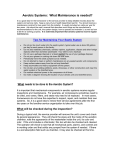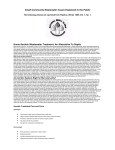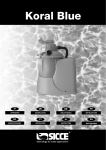Download home aerobic wastewater treatment
Transcript
HOME AEROBIC WASTEWATER TREATMENT: ALTERNATIVE ONSITE WASTEWATER TECHNOLOGY PERMITTING, INSTALLATION, CARE, AND MAINTENANCE. Produced for the Kentucky Division of Water KPDES Branch by the Kentucky Onsite Wastewater Training Center. Funded in part by the United States Environmental Protection Agency. any homes in Kentucky are located in small or rural communities where houses are spaced widely apart. In these communities, central sewerage systems are often not cost-effective, so many homeowners rely on septic systems or other systems that treat and dispose of household wastewater onsite. Some homes for which septic systems are not a good option rely on individual home aerobic systems for wastewater treatment. Aerobic systems are similar to septic systems in that they both use natural processes to treat wastewater. However, unlike septic (anaerobic) treatment, the aerobic treatment process requires oxygen to function. Aerobic treatment systems use mechanisms to inject air and circulate air inside the treatment tank. These mechanisms require electricity and regular maintenance to operate properly. For these reasons, aerobic systems cost more to operate, need more maintenance and routine monitoring. In Kentucky, additional requirements for aerobic systems which discharge directly to surface water or discharge through spray irrigation systems exist. These requirements include: (1) Construction permit issued and approved by the Kentucky Division of Water. (2) Either a discharge or a no discharge permit approved and issued by the Kentucky Division of Water. (3) Additional filtration of the discharge water. (4) Disinfection. (5) Semi-annual discharge monitoring reports for direct discharge permits. (6) A Kentucky certified wastewater plant operator. • • The homeowner, is responsible for the regulatory compliance of the system. The installer is responsible for construction of the treatment system as designed and approved by the Division of Water. Aerobic wastewater treatment may be an option when . . . • The soil is not appropriate • • • • for a conventional septic system. There is high groundwater or shallow bedrock. A higher level of wastewater treatment is required. A septic system has failed and there is no other alternative, and/or There is not enough land available for a septic system. WHY CHOOSE AEROBIC TREATMENT? Although there have been home aerobic systems in the U.S. for more than 50 years, their use has been limited. This is due, in part, to the widespread use of septic systems. Onsite septic tank-soil absorption systems are generally less expensive and are much easier to maintain than aerobic systems. Conventional onsite septic treatment systems are the most common onsite wastewater treatment methods used in rural areas. However, for some households in Kentucky, a conventional system may not meet the requirements for protection of the environment. 1 For example, conventional septic systems are not suitable for every lot. It is estimated that about two-thirds of the land in Kentucky is unsuitable for conventional onsite septic systems. Some homes may not have sufficient land area or suitable soil conditions to accommodate a soil absorption drainfield; the local groundwater tables may be too high to allow adequate treatment of the wastewater, or the underlying geology, such as in the karst areas of the state, may contain solution channels and sinkholes. One of the most common reasons that homeowners and installers consider an aerobic wastewater treatment system is to replace a failing septic system. Failing systems and untreated wastewater are the 4th largest contributors to surface water and groundwater contamination in Kentucky. If a failed system needs replacement or if the site is not suitable for a conventional onsite treatment system, aerobic wastewater treatment may become an option. The remainder of this pamphlet will focus on: 1. Kentucky regulatory requirements for individual home aerobic units. 2. Aerobic treatment pros and cons 3. Is an aerobic system right for my home? 4. How aerobic treatment works 5. Aerobic systems do’s and don’ts 6. Warning signs of aerobic system problems 7. How much does aerobic treatment cost? 8. Aerobic system maintenance 9. Discharge vs. No discharge permit 10. Contacts 2 KENTUCKY REGULATORY REQUIREMENTS FOR INDIVIDUAL HOME AEROBIC UNITS. Before a homeowner can proceed with the installation and operation of an aerobic treatment system in Kentucky, the Kentucky Division of Water (KDOW) KPDES Branch, requires completion of several determining steps for permitting the system. The purpose of these requirements is to protect human health and the valuable groundwater and surface water resources of the state. The first of these requirements is a certification from the local county health department that the site cannot adequately support the installation of “any onsite soil absorption system” and will require the direct discharge of treated wastewater to a stream or by spray irrigation of the treated wastewater to the land surface. This document is submitted to the KDOW along with a permit application for the construction of the aerobic treatment system and proposed discharge alternative. The fee for the permitting process is $450. After KDOW has reviewed the application, it may: (1) Require additional information. (2) Issue a permit. (3) Deny the permit. Be aware that there is no guarantee that the KDOW will approve the permit. A variety of conditions may prevent the use of aerobic onsite treatment. Prior to purchasing land, the homeowner should research onsite treatment alternatives with the local health department and other agencies such as the regional planning districts, the KDOW and the Kentucky Onsite Wastewater Association (KOWA). When construction of an aerobic system is complete, the permittee must submit a written certification to the Division that construction has been completed and tested in accordance with the permit. After your system is in operation, you must monitor the discharge in accordance with the permit issued by the Division. Onsite aerobic sewage treatment plants must be operated at all times by a certified Kentucky wastewater plant operator. For more information on the permit and operation requirements of your system, please contact the KDOW, KPDES Branch at 502-564-3410 or KOWA at 502-839-5082. Aerobic Treatment Pros and Cons Advantages • May provide a higher level of treatment than conventional onsite systems. • Helps to protect water resources where septic systems are failing. • Provides an alternative for sites not suited for septic systems • May extend the life of a drainfield. • May allow for a reduction in drainfield size. Disadvantages • More expensive to construct and operate than a septic system. • Requires a construction and discharge or no-discharge permit from the Kentucky Division of Water. • Requires monitoring for specific pollutants. • Requires monitoring reports be submitted to the Kentucky Division of Water. • Requires a properly certified Kentucky wastewater treatment plant operator. • Requires electricity. • Includes mechanical parts that can break down. • Requires more frequent routine maintenance than a septic tank. • Subject to upsets under sudden heavy loads or when neglected. • May release more pollution to surface and ground water than a septic tank. IS AN AEROBIC SYSTEM RIGHT FOR MY HOME? Aerobic treatment systems are not accepted in all areas. While the Kentucky Division of Water permits spray or direct discharge systems across the state, the local county health department is responsible for making the initial determination for aerobic treatment systems. A major reason that aerobic systems are not more widely used is concern about improper operation and maintenance by homeowners. Aerobic systems require regular maintenance, and abuse or neglect can easily lead to system failure. In response to these concerns, the Kentucky Division of Water and the Department for Public Health require review and approval of these systems. To inquire about review, monitoring and approval of aerobic systems, contact your local county health department or the Kentucky Division of Water. STANDARD 40 AND OTHER RESOURCES AVAILABLE FROM NSF INTERNATIONAL While Standard 40 from NSF International is not accepted as the standard for system approval in Kentucky, it may contain information the homeowner and installer will find useful. Copies of ANSI/NSF Standard 40 Individual Aerobic Wastewater Treatment Plants are available to the public. This standard details all of the product requirements that the NSF uses for the evaluation of aerobic systems leading to NSF approval and is available for $25. NSF also publishes a book titled NSF Listing of Wastewater Treatment Systems and Related Products, Components, and Materials. The book is updated three times a year and includes a complete list of manufacturers and models meeting NSF requirements. The price is $8. For more information or to order these products, contact NSF International at (800) NSF-MARK. Aerobic System Maintenance It is important that mechanical components in aerobic systems receive regular inspection and maintenance. For example, air compressors sometimes need to be oiled, and vanes, filters, and seals may need to be replaced. Malfunctions are common during the first few months after installation. In most cases, homeowners do not have the expertise to inspect, repair, and maintain their own systems. It is a good idea for the homeowner to request a two-year service contact with option for renewal from the installer of the unit. When the initial two-year contract expires, the homeowner should renew the contract or find another maintenance entity to take over the job. In addition to routine maintenance, the service contractor should stock replacement parts for mechanical components and be available for emergency servicing. The service contract may or may not cover such problems as damage from power failures, breaking or crushing of pipes leading to and from the system, flooding, fires, homeowner misuse, and other catastrophes beyond the control of the manufacturer. The installer, dealer, or other independent service organization that has an agreement with the manufacturer will most likely carry out service visits. In some cases the local sanitation or regional planning districts may have additional requirements. The maintenance service contract should be issued to the homeowner and explained before the installation of the system. WHAT TO EXPECT AT A TYPICAL SERVICE VISIT The first service visit should be scheduled immediately after the system is installed to make sure that everything is working correctly. The operator/service contractor may also arrange a meeting with the homeowner to go over issues, such as proper operation, what to do in case of emergency, seasonal properties, etc. The maintenance contract should include at least two service visits per year for the next two years. The number of visits and/or services performed will differ from unit to unit and location to location depending on the manufacturer’s recommendations, local regulations, and the permit issued by the KDOW. During a typical visit, the operator or service provider will remove the unit’s cover and check the system’s general appearance. He or she will check pipes and the inside of the aeration chamber and will note the appearance of the wastewater inside the unit and its color and odor. If the unit includes a chlorinator, this too will be checked and cleaned. Samples may be taken of the mixed liquor (the wastewater undergoing treatment) from the aeration chamber, as well as the final treated wastewater. The operator will also check to see that all mechanical parts, alarms, and controls are in working order and that solids are pumped from the system if needed. The operator/service provider should also inspect the sand filter, discharge lines, spray system, soil absorption field or other method of final disposal. RECORD KEEPING The homeowner should keep detailed records about the system and service visits. This includes copies of the user manual, state permits, monitoring reports, disinfection requirements, and any modifications made to the system. This information should stay with the home in the event of a property transfer. 3 HOW AEROBIC TREATMENT WORKS Aerobic systems treat wastewater using natural processes that require oxygen. Bacteria that thrive in oxygen-rich environments work to break down and digest the wastewater inside the aerobic treatment unit. Like most onsite systems, aerobic systems treat the wastewater in stages. Sometimes the wastewater receives pretreatment before it enters the aerobic unit, and the treated wastewater leaving the unit requires additional treatment by a sandfilter and disinfection before being returned to the environment. Such a variety of designs exists for home aerobic units and systems that it is possible to discuss only the more common design features and the different stages of aerobic treatment. that defy classification. Figures 1, 2, 3 and 4 are typical examples. SUSPENDED GROWTH UNITS The process most aerobic units use to treat wastewater is referred to as suspended growth. These units include a main compartment called an aeration chamber in which air is mixed with the wastewater. Since most home aerobic units are buried underground like septic tanks, the air must be forced into the aeration chamber by an air blower or a compressor. PRETREATMENT Some aerobic systems include a pretreatment step to reduce the amount of solids in the wastewater going into the aerobic unit. Solids include greases, oils, toilet paper, and other materials that are put down the drain or flushed into the system (see the list of what not to flush on page 7). Too much solid material can clog the unit and prevent effective treatment. Some pretreatment methods include a septic tank, a primary settling compartment in the treatment unit, or on some models a trash trap. Pretreatment is optional but can greatly improve a unit’s performance. Figure 1 – An example of a possible aerobic unit design. Kentucky Onsite Wastewater Training Center AEROBIC TREATMENT UNITS 4 The main function of the aerobic unit is to collect and treat household wastewater, which includes all water from toilets, bathtubs, showers, sinks, and laundry. Aerobic units themselves come in many sizes and shapes – rectangular, conical, and some shapes Figure 2 – An example of a possible aerobic unit design. Adapted from the Pipeline – Winter 1996; Vol. 7, No. 1 The forced air mixes with wastewater in the aeration chamber, and the oxygen supports the growth of aerobic bacteria that digest the solids in the wastewater. This mixture of wastewater and oxygen is called the mixed liquor. The treatment occurring in the mixed liquor is referred to as suspended growth because the bacteria grow as they are suspended in the liquid unattached to any surface. Unfortunately, the bacteria cannot digest all of the solids in the mixed liquor, and these solids eventually settle out as sludge. Many aerobic units include a secondary chamber called a settling chamber or clarifier (figure 1) where excess solids can settle. Other designs allow the sludge to accumulate at the bottom of the tank (see figure 4 on page 5). In aerobic units designed with a separate settling compartment, the sludge returns to the aeration chamber (either by gravity or by a pumping device). The sludge contains bacteria that also aid in the treatment process. Typically, the sludge needs to be pumped out when the sludge depth reaches a depth of 1.5 feet so that solids do not clog the unit. When pumping the system, care must to taken to leave about one and one half inch (11/2”) of the sludge in the tank. This provides the necessary bacteria to restart the treatment process. ATTACHED GROWTH UNITS An alternative design for aerobic treatment is the attached growth system. These units treat wastewater by taking a media surface made of inert material that the bacteria can attach to and then exposing that media surface alternatively to wastewater and air. This is done either by rotating the surface in and out of the wastewater or by dosing the wastewater onto the surface. Pretreatment is required on this type system. The air needed for the process is naturally present or is supplied mechanically. Figure 3 – An example of a possible attached growth unit. Adapted from the NETC. Attached growth systems, such as trickling filter and rotating disks, are less common than suspended growth systems, but have certain advantages. For example, there is no need for mixing, and solids are less likely to be washed out of the system during periods of heavy household water use. FLOW DESIGN The way and the rate in which wastewater is received by and flows through the aerobic unit differs from design to design. Continuous flow (on demand) design simply allows the wastewater to flow through the unit at the same rate that it leaves the home. Other designs employ devices (such as pretreatment tanks, surge chambers, baffles, and pumps) to control the amount of wastewater flowing to the aeration compartment. Batch process designs use pumps or siphons to control the amount of wastewater in the aeration compartment and/or to discharge the treated wastewater in controlled amounts after a certain period of time. Controlling the flow of wastewater helps to protect and increase the efficiency of the treatment process. When too much wastewater is flushed into the system all at once, it can become overburdened, and the quality of treatment can suffer. The disadvantages to mechanical flow control devices are that, like all mechanical components, they need maintenance and run the risk of malfunctioning. Figure 4 – An example of a possible aerobic unit design. Adapted from the Pipeline – Winter 1996; Vol. 7, No. 1 Homeowners can help their system’s performance by conserving water. Leaking faucets and running toilets should be repaired, and washing machines and dishwashers should be used only for full loads. Installing water saving devices in toilets, faucets, and showers can reduce water use by up to 50 percent. In addition, homeowners should try to space out activities requiring heavy water use (like laundry) to avoid overloading their systems. FINAL TREATMENT AND DISPOSAL When properly operated and maintained, aerobic units can be very effective in reducing waste strength. The wastewater from the units is now ready for return to the environment but must receive final treatment and disinfection if discharged to a stream or spray irrigation system. Methods for final (tertiary) treatment include discharge to a soil absorption field, a sandfilter, an evapo-transpiration bed, a lagoon, direct discharge or a spray irrigation system. The Kentucky Division of Water requires that all wastewater discharge to a receiving stream receive final treatment using a sand filter and a disinfection process (chlorination, dechlorination, UV, etc.) . The wastewater from the aerobic unit is pumped evenly over several layers of sand and gravel, which are located either above or below ground. As with soil treatment systems, the sand filter aids in the removal of solids that may have passed through the system. In addition, bacteria that occur naturally in the sand aid the purification process. The KDOW also requires disinfection of the wastewater before direct discharge or spray irrigation. Some units have the disinfection process incorporated into the unit design. Other systems may require installation of additional components. Added costs for disinfection, such as chlorine, should be taken into account with aerobic units. OTHER DESIGN CONSIDERATIONS Controls and Alarms Most aerobic units have controls that can be switched on and off by the homeowner in case of emergency. Aerobic units are also required to have alarms to alert the homeowner of malfunctions. Depending on the design of the system, controls and alarms can be located either inside or outside the home, and alarms must be both visible and audible. Homeowners should make sure that controls and alarms meet local electrical code and that the aerobic unit is turned back on if there is a power outage or if it is turned off temporarily. Size Aerobic units should be large enough to allow enough time for the solids to settle and for the wastewater to be treated. The size of most units treatment capacity range from 750 to 1,500 gallons per day. The Kentucky Division of Water requires systems be able to process a minimum of 500 gallons per day. Temperature Lower temperatures tend to slow down most biological processes, and higher temperatures tend to speed them up. The aerobic process itself creates heat, which along with the heat from the incoming wastewater and the heat from electrical components, may help to keep the treatment system active. However, cold weather can have adverse effects on aerobic units. In a 1977 study of aerobic units, bulking of the sludge seemed to occur when the temperature of the mixed liquor fell below 15 degrees Celsius (59 degrees Fahrenheit). Problems can sometimes be avoided by insulating around the unit. This may be an additional consideration in selecting and installing the appropriate aerobic system. Warning Signs of Aerobic System Problems Alarms or lights going off. Any change in the system’s normal operating sound. Plumbing backups. Sewage odor in the house or yard. Excessive solids, foam, or scum in the unit. Any change in the normal chocolate brown color of the wastewater in the aeration chamber. 5 AEROBIC SYSTEM DO’s AND DON’Ts DO’s DO read and understand the permit requirements for operating and monitoring your aerobic treatment system. DO maintain the contract service arrangement offered by the manufacturer, installer, or contractor. It is extremely important that aerobic systems receive regular maintenance. DO keep your system accessible for inspection and pumping, yet protected from unauthorized entrance. Keep your system components locked and make sure that your service contractor has a key. DO call a service professional whenever you experience problems with your system, whenever the alarm is activated, or whenever there are any signs of system failure. DO keep detailed records about your aerobic system, including a map of where it is, and general information, such as model name or number, installer’s name, capacity, state license, date installed, contract service agreement, records of service visits, maintenance performed, and monitoring records. DO conserve water to avoid overloading the system. Be sure to repair any leaky faucets or toilets. DO divert other sources of water, like roof drains, house footing drains, and sump pumps away from the system. DO become familiar with how your system operates and the way it looks, sounds, and smells when it is working properly. This way, you may be able to identify problems before they become serious and alert your service provider DO be sure to ask your service provider questions about how to know if your unit is malfunctioning. 6 DO’s DO limit the loads of laundry to two loads per day. Excessive amounts of water entering the system at one time, especially water that contains detergent, dyes, salts, chemicals, etc., can weaken the bacteria in the system. DO limit amounts of liquid detergents, bleaches, toilet bowl cleaners, drain cleaners and harsh chemicals such as permanent wave solution, dyes, etc., that enter the system. Use these products as necessary and only in the required amounts. DO monitor chlorine regularly to ensure that the output of the system is properly disinfected. This protects you, your family, neighbors, pets, and the environment. DO realize that when members of the household are ill and are placed on antibiotics that the treatment system might be affected. The system should return to normal when the antibiotics are no longer in use. DO expect temporary changes in your system during or after family and holiday gatherings. During these times large amounts of water are induced into the system. This increase will bring the system out of balance from normal household usage. It will normally take three to five days for the system to return to normal operation. An odor could be experienced during this period. DO have the sludge pumped from the system every three to five years or when the sludge level reaches 1.5 feet in the tank. Always leave about 1 1/2 inches of sludge in the tank to restart the process. DO use baking soda to clean drains and dispose of old baking soda down the drain. This helps control the pH balance of the system. DON’Ts DON’T allow anyone to drive over or park on any part of the system. DON’T make or allow unauthorized repairs or changes to your aerobic system without obtaining the required Division of Water Permits. DON’T use your toilet as a trash can or poison your treatment system and the groundwater by pouring harmful chemicals down the drain. Harsh chemicals can kill the beneficial bacteria that treat your wastewater. DON’T attempt to clean or perform maintenance on any sealed aerobic unit components. DON’T use water softeners with aerobic systems. Water softeners produce excessive amounts of salts, which when introduced to the system will kill the necessary bacteria and destroy the pH balance. DON’T change any settings on the system’s components, such as the time clock, diffusers, or sludge returns. Any change, even slight, can change the operation of the system. This may slow the growth of bacteria resulting in odors and improper treatment. DON’T empty hot tubs or whirl pools due to the excessive amounts of water and chemicals. DON’T feed tank additives, such as packaged formulas, into the unit. DON’T flush: coffee grounds, dental floss, disposable diapers, kitty litter, sanitary napkins, tampons, cigarette butts, condoms, gauze bandages, fat, grease, oil, paper towels, paints, varnishes, thinners, waste oils, photographic solutions, pesticides, or other harsh chemicals into the system. DON’T use ion-exchange water softening systems, specially those discharging into soil absorption systems. HOW MUCH DOES AEROBIC TREATMENT COST? The cost of aerobic treatment varies depending on many factors, such as design, size, location, and operation and maintenance requirements. Some of the factors affecting the cost of aerobic treatment are as follows: CONTACTS Kentucky Division of Water (502) 564-3410 http://water.nr.state.ky.us/dow/ Unit Price. Cost of unit installation and electricians’ fees. Cost of construction of the drainfield, discharge line, spray irrigation components or cost of other method of additional treatment such as sand filter and disinfection. Cost of electricity (per year). Maintenance service contract fee (per year) The price of some of these factors, such as unit price, may be adversely affected by the lack of demand for aerobic systems in certain areas. Installation costs may be higher for aerobic units than for septic tanks because of the electrical work required. All of these factors need to be carefully considered when determining the cost-effectiveness of aerobic treatment versus other treatment methods. Your local health department, the Kentucky Division of Water, installers, and contractors can help you evaluate your options. DO NOT FLUSH… Coffee grounds Dental floss Disposable diapers Kitty litter Sanitary napkins Tampons Cigarette butts Condoms Gauze bandages Fat, grease, or oil Paper towels Plastics Never flush chemicals, Paints Varnishes Thinners Waste oil Photographic solutions Pesticides Antibiotics or other medications. As with septic systems, these items can overtax or destroy the biological digestion taking place within your aerobic unit. Kentucky Onsite Wastewater Training Center (502) 839-5082 www.kentuckyonsite.org National Small Flows Clearing House (800) 624-8301 www.estd.wvu.edu/nsfc/ Kentucky Department for Public Health, Environmental Services (502) 564-4856 http://publichealth.state.ky.us/ Information contained in this publication was developed and reviewed by the Kentucky Division of Water and the Kentucky Onsite Wastewater Training Center. Support for development and/or funding was provided in part by Kentucky Onsite Wastewater Association, the Kentucky Division of Water, and the U.S. EPA. Please address comments to the contacts listed above. Portions of this publication were extracted from the Winter 1996 Vol. 7 No. 1 Pipeline published by the: National Small Flows Clearinghouse West Virginia University P.O. Box 6064, Morgantown, WV 26506-6064 7 Kentucky Division of Water


















